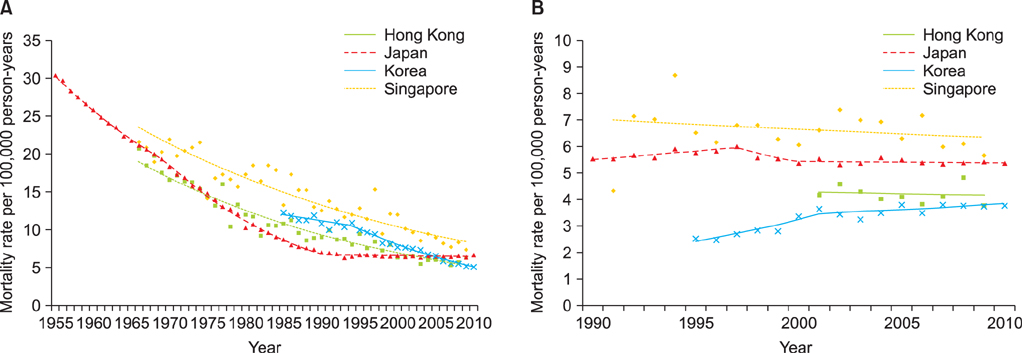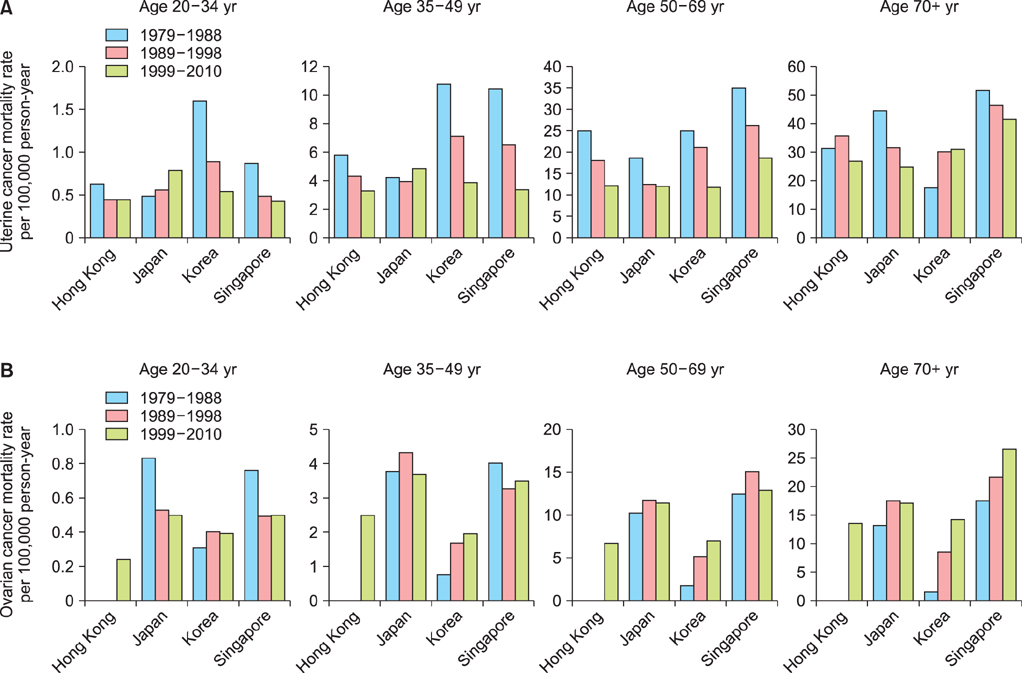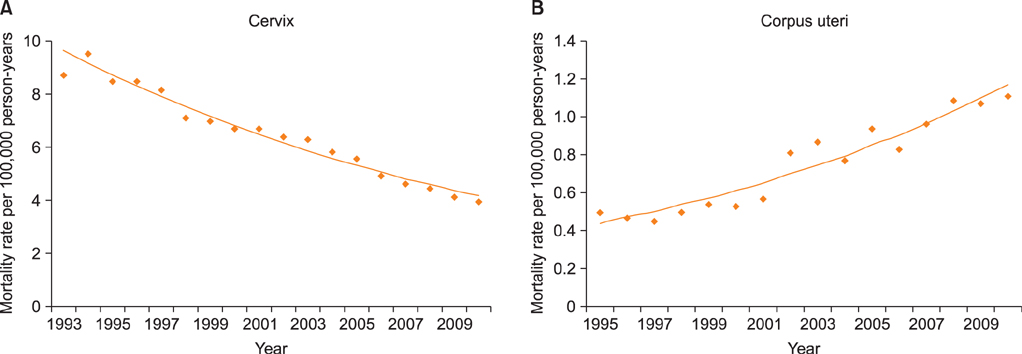Trends in gynecologic cancer mortality in East Asian regions
- Affiliations
-
- 1Department of Obstetrics and Gynecology, Seoul National University College of Medicine, Seoul, Korea.
- 2Cancer Registration and Statistics Branch, National Cancer Center, Goyang, Korea. astra67@ncc.re.kr
- 3Molecular Epidemiology Branch, National Cancer Center, Goyang, Korea.
- 4Department of Obstetrics and Gynecology, University of Hong Kong, Hong Kong.
- 5Department of Obstetrics and Gynecology, Keio University School of Medicine, Tokyo, Japan.
- 6Department of Obstetrics and Gynecology, National University Hospital, Singapore.
- KMID: 2130097
- DOI: http://doi.org/10.3802/jgo.2014.25.3.174
Abstract
OBJECTIVE
To evaluate uterine and ovarian cancer mortality trends in East Asian countries.
METHODS
For three Asian countries and one region (Japan, Korea, Singapore, and Hong Kong), we extracted number of deaths for each year from the World Health Organization (WHO) mortality database, focusing on women > or =20 years old. The WHO population data were used to estimate person-years at risk for women. The annual age-standardized, truncated rates were evaluated for four age groups. We also compared age-specific mortality rates during three calendar periods (1979 to 1988, 1989 to 1998, and 1999 to 2010). Joinpoint regression was used to determine secular trends in mortality. To obtain cervical and uterine corpus cancer mortality rates in Korea, we re-allocated the cases with uterine cancer of unspecified subsite according to the proportion in the National Cancer Incidence Databases.
RESULTS
Overall, uterine cancer mortality has decreased in each of the Asian regions. In Korea, corrected cervical cancer mortality has declined since 1993, at an annual percentage change (APC) of -4.8% (95% confidence interval [CI], -5.3 to -4.4). On the other hand, corrected uterine corpus cancer mortality has abruptly increased since 1995 (APC, 6.7; 95% CI, 5.4 to 8.0). Ovarian cancer mortality was stable, except in Korea, where mortality rates steadily increased at an APC of 6.2% (95% CI, 3.4 to 9.0) during 1995 to 2000, and subsequently stabilized.
CONCLUSION
Although uterine cancer mortality rates are declining in East Asia, additional effort is warranted to reduce the burden of gynecologic cancer in the future, through the implementation of early detection programs and the use of optimal therapeutic strategies.
Keyword
MeSH Terms
Figure
Cited by 7 articles
-
Pretreatment neutrophil-to-lymphocyte ratio and its dynamic change during neoadjuvant chemotherapy as poor prognostic factors in advanced ovarian cancer
Yun-Ji Kim, Inha Lee, Young Shin Chung, EunJi Nam, Sunghoon Kim, Sang-Wun Kim, Young Tae Kim, Jung-Yun Lee
Obstet Gynecol Sci. 2018;61(2):227-234. doi: 10.5468/ogs.2018.61.2.227.The influence of hormone therapy with drospirenone-estradiol on endometrioid type endometrial cancer patients
Soyi Lim, Yun Hwan Kim, Kwang-Beom Lee, Jong-Min Lee
J Gynecol Oncol. 2018;29(5):. doi: 10.3802/jgo.2018.29.e72.Incidence and costs of cervical intraepithelial neoplasia in the Korean population
Ha Kyun Chang, Sang-Soo Seo, Jun-Pyo Myong, Ye Lee Yu, Seung Won Byun
J Gynecol Oncol. 2019;30(3):. doi: 10.3802/jgo.2019.30.e37.Outcomes of Non-High Grade Serous Carcinoma after Neoadjuvant Chemotherapy for Advanced-Stage Ovarian Cancer: Single-Institution Experience
Young Shin Chung, Jung-Yun Lee, Hyun-Soo Kim, Eun Ji Nam, Sang Wun Kim, Young Tae Kim
Yonsei Med J. 2018;59(8):930-936. doi: 10.3349/ymj.2018.59.8.930.Integrating a Next Generation Sequencing Panel into Clinical Practice in Ovarian Cancer
Yong Jae Lee, Dachan Kim, Hyun-Soo Kim, Kiyong Na, Jung-Yun Lee, Eun Ji Nam, Sang Wun Kim, Sunghoon Kim, Young Tae Kim
Yonsei Med J. 2019;60(10):914-923. doi: 10.3349/ymj.2019.60.10.914.Impact of increased utilization of neoadjuvant chemotherapy on survival in patients with advanced ovarian cancer: experience from a comprehensive cancer center
Yong Jae Lee, Young Shin Chung, Jung-Yun Lee, Eun Ji Nam, Sang Wun Kim, Sunghoon Kim, Young Tae Kim
J Gynecol Oncol. 2018;29(4):e63. doi: 10.3802/jgo.2018.29.e63.Impact of increased utilization of neoadjuvant chemotherapy on survival in patients with advanced ovarian cancer: experience from a comprehensive cancer center
Yong Jae Lee, Young Shin Chung, Jung-Yun Lee, Eun Ji Nam, Sang Wun Kim, Sunghoon Kim, Young Tae Kim
J Gynecol Oncol. 2018;29(4):. doi: 10.3802/jgo.2018.29.e63.
Reference
-
1. Felay J, Shin H, Bray F, Forman D, Mathers C, Parkin D. GLOBOCAN 2008: cancer incidence and mortality worldwide: IARC CancerBase No. 10. Lyon: IARC Press;2010.2. Akhtar-Danesh N, Elit L, Lytwyn A. Temporal trends in the relative survival among women with cervical cancer in Canada: a population-based study. Int J Gynecol Cancer. 2012; 22:1208–1213.3. Bray F, Loos AH, Tognazzo S, La Vecchia C. Ovarian cancer in Europe: cross-sectional trends in incidence and mortality in 28 countries, 1953-2000. Int J Cancer. 2005; 113:977–990.4. Gonzalez-Diego P, Lopez-Abente G, Pollan M, Ruiz M. Time trends in ovarian cancer mortality in Europe (1955-1993): effect of age, birth cohort and period of death. Eur J Cancer. 2000; 36:1816–1824.5. Hannibal CG, Cortes R, Engholm G, Kjaer SK. Survival of ovarian cancer patients in Denmark: excess mortality risk analysis of five-year relative survival in the period 1978-2002. Acta Obstet Gynecol Scand. 2008; 87:1353–1360.6. Chung HH, Jang MJ, Jung KW, Won YJ, Shin HR, Kim JW, et al. Cervical cancer incidence and survival in Korea: 1993-2002. Int J Gynecol Cancer. 2006; 16:1833–1838.7. Katanoda K, Matsuda T, Matsuda A, Shibata A, Nishino Y, Fujita M, et al. An updated report of the trends in cancer incidence and mortality in Japan. Jpn J Clin Oncol. 2013; 43:492–507.8. Cramer DW. The epidemiology of endometrial and ovarian cancer. Hematol Oncol Clin North Am. 2012; 26:1–12.9. Pasalich M, Su D, Binns CW, Lee AH. Reproductive factors for ovarian cancer in southern Chinese women. J Gynecol Oncol. 2013; 24:135–140.10. World Health Organization Statistical Information System. WHO mortality database [Internet]. Geneva: World Health Organization;c2014. cited 2013 Jul 29. Available from: http://www.who.int/healthinfo/mortality_data/en/.11. World Health Organization. International statistical classification of idseases and related health problems. Geneva: World Health Organization;1994.12. Arbyn M, Geys H. Trend of cervical cancer mortality in Belgium (1954-1994): tentative solution for the certification problem of unspecified uterine cancer. Int J Cancer. 2002; 102:649–654.13. Bosch FX. Trends in cervical cancer mortality. J Epidemiol Community Health. 1999; 53:392.14. Levi F, Lucchini F, Negri E, Franceschi S, la Vecchia C. Cervical cancer mortality in young women in Europe: patterns and trends. Eur J Cancer. 2000; 36:2266–2271.15. Loos AH, Bray F, McCarron P, Weiderpass E, Hakama M, Parkin DM. Sheep and goats: separating cervix and corpus uteri from imprecisely coded uterine cancer deaths, for studies of geographical and temporal variations in mortality. Eur J Cancer. 2004; 40:2794–2803.16. Shin HR, Won YJ, Jung KW, Kong HJ, Yim SH, Lee JK, et al. Nationwide cancer incidence in Korea, 1999-2001: first result using the national cancer incidence database. Cancer Res Treat. 2005; 37:325–331.17. Shin HR, Park S, Hwang SY, Kim JE, Jung KW, Won YJ, et al. Trends in cervical cancer mortality in Korea 1993-2002: corrected mortality using national death certification data and national cancer incidence data. Int J Cancer. 2008; 122:393–397.18. Segi M, Fujisaku S. Cancer mortality for selected sites in 24 countries (1950-1957). Sendai: Department of Public Health, Tohoku University School of Medicine;1960.19. Joinpoint Regression Program version 3.5.3 [Internet]. 2012 ed. Bethesda, MD: National Cancer Institute;2012. cited 2012 Aug 5. Available from: http://surveillance.cancer.gov/joinpoint/.20. Ministry of Health. National Registry of Disease Office [Interent]. Singapore: Ministry of Health;c2013. cited 2013 Nov 3. Available from: https://www.nrdo.gov.sg/page.aspx?id=76.21. Jemal A, Siegel R, Ward E, Hao Y, Xu J, Thun MJ. Cancer statistics, 2009. CA Cancer J Clin. 2009; 59:225–249.22. Minelli L, Stracci F, Prandini S, Moffa IF, La Rosa F. Gynaecological cancers in Umbria (Italy): trends of incidence, mortality and survival, 1978-1998. Eur J Obstet Gynecol Reprod Biol. 2004; 115:59–65.23. Remontet L, Esteve J, Bouvier AM, Grosclaude P, Launoy G, Menegoz F, et al. Cancer incidence and mortality in France over the period 1978-2000. Rev Epidemiol Sante Publique. 2003; 51(1 Pt 1):3–30.24. Jung KW, Won YJ, Kong HJ, Oh CM, Seo HG, Lee JS. Cancer statistics in Korea: incidence, mortality, survival and prevalence in 2010. Cancer Res Treat. 2013; 45:1–14.25. Chen YY, You SL, Chen CA, Shih LY, Koong SL, Chao KY, et al. Effectiveness of national cervical cancer screening programme in Taiwan: 12-year experiences. Br J Cancer. 2009; 101:174–177.26. Keys HM, Bundy BN, Stehman FB, Muderspach LI, Chafe WE, Suggs CL 3rd, et al. Cisplatin, radiation, and adjuvant hysterectomy compared with radiation and adjuvant hysterectomy for bulky stage IB cervical carcinoma. N Engl J Med. 1999; 340:1154–1161.27. Kokawa K, Takekida S, Kamiura S, Kita M, Enomoto T, Kawaguchi R, et al. The incidence, treatment and prognosis of cervical carcinoma in young women: a retrospective analysis of 4,975 cases in Japan. Eur J Gynaecol Oncol. 2010; 31:37–43.28. Banzai C, Yahata T, Tanaka K. Trends in the incidence of uterine cancer in Niigata, Japan: a population-based study from 1982 to 2007. Eur J Gynaecol Oncol. 2011; 32:521–524.29. Yang L, Fujimoto J, Qiu D, Sakamoto N. Trends in cancer mortality in Japanese adolescents and young adults aged 15-29 years, 1970-2006. Ann Oncol. 2009; 20:758–766.30. Arbyn M, Castellsague X, de Sanjose S, Bruni L, Saraiya M, Bray F, et al. Worldwide burden of cervical cancer in 2008. Ann Oncol. 2011; 22:2675–2686.31. Huang CY, Chen CA, Chen YL, Chiang CJ, Hsu TH, Lin MC, et al. Nationwide surveillance in uterine cancer: survival analysis and the importance of birth cohort: 30-year population-based registry in Taiwan. PLoS One. 2012; 7:e51372.32. D'Angelo E, Prat J. Uterine sarcomas: a review. Gynecol Oncol. 2010; 116:131–139.33. Parkin DM, Bray F, Ferlay J, Pisani P. Global cancer statistics, 2002. CA Cancer J Clin. 2005; 55:74–108.34. Lim MC, Moon EK, Shin A, Jung KW, Won YJ, Seo SS, et al. Incidence of cervical, endometrial, and ovarian cancer in Korea, 1999-2010. J Gynecol Oncol. 2013; 24:298–302.35. Wingo PA, Cardinez CJ, Landis SH, Greenlee RT, Ries LA, Anderson RN, et al. Long-term trends in cancer mortality in the United States, 1930-1998. Cancer. 2003; 97:12 Suppl. 3133–3275.36. Mant JW, Vessey MP. Ovarian and endometrial cancers. Cancer Surv. 1994; 19-20:287–307.37. Zheng X, Tan L, Ren Q, Cui Z, Wu J, Lin T, et al. Trends in contraceptive patterns and behaviors during a period of fertility transition in China: 1988-2006. Contraception. 2012; 86:204–213.38. Skouby SO. Contraceptive use and behavior in the 21st century: a comprehensive study across five European countries. Eur J Contracept Reprod Health Care. 2010; 15:Suppl 2. S42–S53.39. Central Intelligence Agency. CIA world factbook [Internet]. Washington, DC: Central Intelligence Agency;c2013. cited 2013 Nov 3. Available from: https://www.cia.gov/library/publications/the-world-factbook/.40. Wong KH, Mang OW, Au KH, Law SC. Incidence, mortality, and survival trends of ovarian cancer in Hong Kong, 1997 to 2006: a population-based study. Hong Kong Med J. 2012; 18:466–474.41. Bouchardy C, Rapiti E, Blagojevic S, Vlastos AT, Vlastos G. Older female cancer patients: importance, causes, and consequences of undertreatment. J Clin Oncol. 2007; 25:1858–1869.42. Jorgensen TL, Teiblum S, Paludan M, Poulsen LO, Jorgensen AY, Bruun KH, et al. Significance of age and comorbidity on treatment modality, treatment adherence, and prognosis in elderly ovarian cancer patients. Gynecol Oncol. 2012; 127:367–374.
- Full Text Links
- Actions
-
Cited
- CITED
-
- Close
- Share
- Similar articles
-
- Annual report of gynecologic cancer registry program in Korea: 1991~2004
- Practical issues and research trends of oncofertility in gynecologic cancer
- East Asian Gynecologic Oncology Trial Group (EAGOT): founding history and future perspective
- Cancer Control Programs in East Asia: Evidence From the International Literature
- Current treatment strategies for ovarian cancer in the East Asian Gynecologic Oncology Trial Group (EAGOT)




